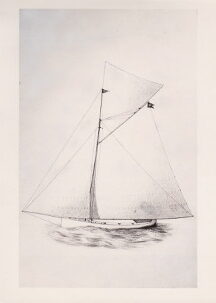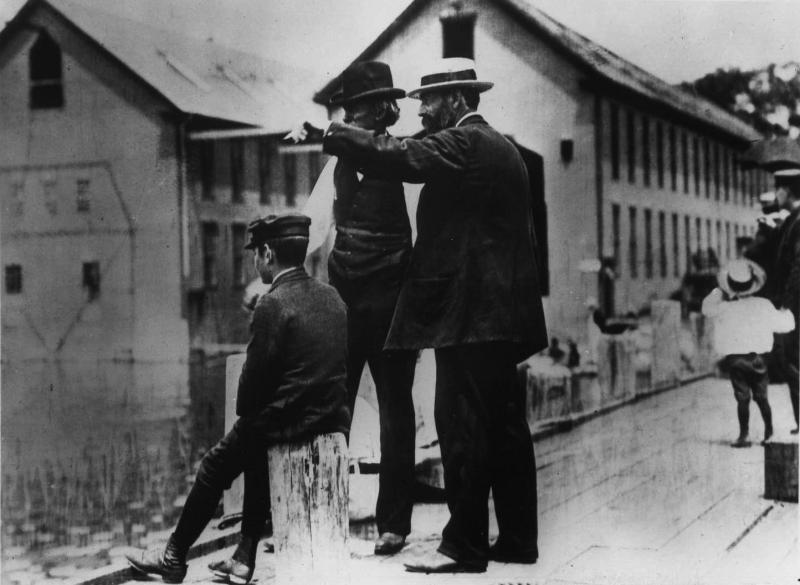January 1, 2018
The Curator’s Log: January 2018
Nathanael Greene Herreshoff; The Dishonorable Press and Fake News

Nathanael Greene Herreshoff & The "Dishonorable Press"
Introduction
Captain Nat Herreshoff believed very strongly in an individual’s right of privacy and as a professional that he had sole ownership of his secrets unless he chose to publish them himself. The individual through ability and industriousness had the right to make progress in his chosen profession unfettered by theft and unapproved disclosure of his ideas and creations. This brought him into conflict with a “dishonorable” press eager to learn and divulge the details of his latest project.
HMCo. and the Press in the Early Steam Years
When growing his new business in the 1870s and 80s J.B.H. sought out the press to extoll his products. He was always willing to give a reporter a ride, an interview and a story whether spontaneously while trialing a new boat in Newport harbor or stopping at Wall Street on a delivery trip. In return he was looked upon most favorably by the press who saw J.B., "as the obliging and courteous builder, owner and master (of whatever vessel he was demonstrating)". He went out of his way to help with their stories, such as placing a steamer at their disposal to file reports of President Grant’s visit to Bristol in 1875. And while brother Nat was engaged in running the Corliss engine to power the 1876 Philadelphia Centennial celebration, JB was gaining positive attention in all the major newspapers by running “public tests” of his newest steam yacht on the Schuylkill River. Afterwards JB enjoyed the reporters’ stories as read to him by wife Sarah; not knowing she religiously deleted any words referring to his blindness. 1
HMCo. and the Press in the America's Cup Years
The 1891 success of GLORIANA and the start of building America’s Cup boats in 1892 brought new interest by the press into what was going on within the confines of the Herreshoff works as well as reporting on the activities of Nat Herreshoff. J.B. still made the contract announcements and courted press attention on delivery of steam yachts, but it was the design genius, Capt. Nat, who now was the big attraction. What is his new design being built behind those closed doors? What does he have to say?
The shops and piers of the Herreshoff Manufacturing Company (HMCo. were closed in 1892 when work started on the Cup contenders COLONIA and VIGILANT. Because VIGILANT was still under construction, the early 1893 launchings of NAVAHOE and COLONIA were closed shop affairs held without any public announcement. The gates were opened again for the launching of VIGILANT before a large crowd because the need for secrecy was over.2 That practice was continued in subsequent Cup years. “Woe be to the prying newspaper reporters and others who attempt to get into the shops without a pass,” lamented the Bristol Phoenix in 1895.3
The reporters found Capt. Nat harder to interview than it was to gain access to the works. “…no more unsatisfactory subject was ever attacked by ubiquitous pencil pushers…. On general principles …(he) objects to conversations with strangers, but is particularly adverse to discussing affairs that he considers his own…” (Seldom) “… gave (a) reporter enough monosyllabic answers to warrant publication.”4 And at times he could be belligerent, such as when he destroyed the glass plate negative of a reporter who had the affront to take Capt. Nat’s photograph out on Hope Street. 5
The press frustrated by the security measures and the inability to obtain newsworthy interviews became more aggressive. In Capt. Nat’s eyes,
“The reporters did so many things that were dishonorable, and trying to steal information that they knew was not to be published, they got a bad name with us.”6
“… we were continually pestered by those young men who were sent out to gather news to fill up their columns by unprincipled persons and to steal information and even drawings if they were not given voluntarily. And if we protected shops and rights to well the young pen-wielders would attempt to belittle us and our products in their writings whenever possible.”7
Capt. Nat had reasons for these opinions.
"Fake" News: Following VIGILANT’s America’s Cup victory several interviews that he empathically denied were published.
Personal dislike by the press- “We may not like the man but every fair minded person must respect his genius“.8
Theft/disclosure of HMCo. drawings: In spite of the strict HMCo employee rules promising removal for divulging project information, description and illustrations of important design features were divulged by the press;
• “… I worked out the schemes (for longitudinal construction) and first used it in the design of the cup defender “Constitution” in the fall of 1900. This yacht was completed in May 1901 and just about the time of completion Scientific American came out with a very complete description with illustrations of the construction of that yacht, which they must have obtained from some one in employment who was working on her.”9
Getting the story wrong: The failure of the new Herreshoff design, CONSTITUTION, to win the competition to defend the 1901 Cup proved a field day for those looking to place blame;
• “The one and sole cause of CONSTITUTION’s failure was the incompetency of those in charge. Nor is Mr. Herreshoff wholly blameless in this matter. It is said he was largely responsible for the selection of the skipper and crew.” (The Rudder Oct. 1901, Thomas Fleming Day)
• “(Manager) Butler Duncan was very sincere and loyal to his country and decided to have his crew all native born. He passed by taking Charlie Barr, who had become a naturalized citizen, and unwisely selected a “schooner man” for sailing master.” (Capt. Nat, Recollections, “Some of the Boats I Have Sailed In”. Page 65)
Unauthorized examination of Cup boats under construction: In the week before launching of the 1895 DEFENDER, and under the headline “A PICTURE AT ANY COST”, the Bristol Phoenix recounted the rough treatment received by newsmen in their attempts to view the vessel. Unable to get by the sentry box the interlopers made several attempts from the waterside:10
• Young men swam over to the south shop and went underneath the building to take a look at DEFENDER. The watchman “showered rivets on them until they were glad to leave”.
• A news artist in a boat obtained a good sketch of DEFENDER through the open shop launch way doors while being pelted unsuccessfully with spikes and other missiles thrown by workmen. This was all witnessed by JB and Capt. Nat who were “very angry” they could not prevent the sketches.
• Another approach by two men in a boat to get a photo of DEFENDER through a slit in the launch way door was foiled by deploying a steam hose from a steamer at the pier.
• “A man with a camera in his sleeve and a heart for any fate”gained access to the pile driver laying the new ways for launching DEFENDER. Before he could operate his camera he was pulled bodily from the boat by a slip noose thrown over him from the windows of the small sail loft overhead. He was then subjected to a plunge bath in the harbor before extricating himself from the lasso.
When Capt. Nat passed in February 1938 he was well–treated by the press, but even then his obituary contained a mischaracterization. Many papers cited a 1921 honorarium from the American Society of Mechanical Engineers recognizing Capt. Nat as “as a man who never patented an invention or design, but willingly gave them to the world.”11
That is not an apt description of Capt. Nat, who filed a number of patents and worked diligently his whole life to shield his professional secrets, save for allowing the publishing of his “Herreshoff Rules for Wooden Yachts”; but that did not occur until 1927.
John Palmieri
1 Developed from news stories contained in the Sadie L. Herreshoff March 1875 Newspaper Cuttings Book, in which Sadie, wife of JB, pasted news cuttings from 1870 to 1882. It is part of the Louise DeWolf Collection of the Herreshoff Marine Museum archives. For a more detailed account of the stories see the Curator Log October 2013.
2 “Launch of New 84-foot Boat, Carroll’s NAVAHOE”. Boston Sunday Globe, Feb. 18, 1893; “COLONIA launched”. Bristol Phoenix, May 20, 1893; “Busy Week at Bristol”. Boston Globe, June 18, 1893.
3 The Bristol Phoenix, Feb. 1, 1895.
4 “Nat Herreshoff Talks”. Providence Journal, July 28, 1894.
5 The Bristol Phoenix, March 13, 1903.
6 N. G. Herreshoff & W. P. Stephens. Annotated by John W. Streeter. Their Last letters 1930-1938. Herreshoff Marine Museum. NGH Letter Three June 12, 1930, page 20.
7 Ibid., NGH Letter Thirteen Aug. 31, 1935, page 78.
8 Thomas Fleming Day, The Rudder Oct. 1901,
9 NGH letter of Nov. 1, 1922 to James Swan, US Shipping Board Emergency Fleet Corp. HMM Archives.
10 The Bristol Phoenix, June 28, 1895.
1 Developed from news stories contained in the Sadie L. Herreshoff March 1875 Newspaper Cuttings Book, in which Sadie, wife of JB, pasted news cuttings from 1870 to 1882. It is part of the Louise DeWolf Collection of the Herreshoff Marine Museum archives. For a more detailed account of the stories see the Curator Log October 2013.
2 “Launch of New 84-foot Boat, Carroll’s NAVAHOE”. Boston Sunday Globe, Feb. 18, 1893; “COLONIA launched”. Bristol Phoenix, May 20, 1893; “Busy Week at Bristol”. Boston Globe, June 18, 1893.
3 The Bristol Phoenix, Feb. 1, 1895.
4 “Nat Herreshoff Talks”. Providence Journal, July 28, 1894.
5 The Bristol Phoenix, March 13, 1903.
6 N. G. Herreshoff & W. P. Stephens. Annotated by John W. Streeter. Their Last letters 1930-1938. Herreshoff Marine Museum. NGH Letter Three June 12, 1930, page 20.
7 Ibid., NGH Letter Thirteen Aug. 31, 1935, page 78.
8 Thomas Fleming Day, The Rudder Oct. 1901,
9 NGH letter of Nov. 1, 1922 to James Swan, US Shipping Board Emergency Fleet Corp. HMM Archives.
10 The Bristol Phoenix, June 28, 1895.
11 “Captain Herreshoff, 91 Dies at Bristol Home”, The Newport Mercury and Weekly News, June 3, 1938.


